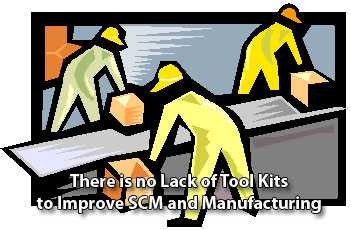Even within Lean, there are two main branches or philosophies:
TPS: The founding concept, which in addition to the principles mentioned above relies strongly on the concept of Just-in-Time (JIT) inventories, which are achieved by achieving a pull-based system, continuous flow, and predictable cycle times. However, some believe that traditional TPS does not do a good job of handling scenarios with high product mix, shared production assets across products, and volatile demand.
DFT: Partly in response to the limitations of TPS in some scenarios, in the 1980s consultant John Constanza developed a set of tools known as Demand Flow Technology (DFT). DFT is primarily a set of mathematical tools to coordinate work flow into a synchronized stream, achieving balance and greater flexibility that TPS thinking may sometimes provide.
 Six Sigma: Springing from the ideas of quality guru Edwards Demings, Six Sigma is a quality improvement methodology that, in general, seeks to reduce process and results variation. The term comes from statistical measures of this deviance, which at a Six Sigma level means there would be only 3.4 defects in a process/product per million “opportunities.” Six Sigma: Springing from the ideas of quality guru Edwards Demings, Six Sigma is a quality improvement methodology that, in general, seeks to reduce process and results variation. The term comes from statistical measures of this deviance, which at a Six Sigma level means there would be only 3.4 defects in a process/product per million “opportunities.”
In the US, Six Sigma was championed in manufacturing by such companies as Honeywell/Allied Signal and GE, to their great benefit. The most popular approach is known as the DMAIC methodology, consisting of five steps: Define, Measure, Analyze, Improve and Control.
As with Lean, the technique has branched out beyond manufacturing to other supply chain and general business processes.
Theory of Constraints: Developed by the legendary Dr. Eli Goldratt, Theory of Constraints (TOC) is an approach that focuses on finding the single constraint that is limiting the performance of a given system. As that constraint is fixed/relaxed, or the system is optimized around this constraint, another constraint will emerge, and that constraint is then tackled, as are subsequent ones, each time improving overall system performance.
While there are also many tools in the TOC playbook, a key one is the concept of “Drum-Buffer-Rope”: the drum – the constraint or weakest link; the buffer - the material release duration; and the rope – the release timing. The aim of the solution is to protect the weakest link in the system and, therefore, the system as a whole against process dependency and variation and, thus, maximize the system’s overall effectiveness.
Hybrid Approaches
Of course, many companies and consultants have opted to combine these methodologies in one form or another.
The most popular is Lean Six Sigma. In general, using this approach a company seeks to improve results by using Lean to streamline processes and eliminate waste, then improve the consistency and reliability of those processes using Six Sigma.
There are several principles that drive the strategy of bringing Lean and Six Sigma together:
- Lean cannot bring a process under statistical control
- Six Sigma alone cannot dramatically improve process speed or reduce invested capital
- Both enable the reduction of the cost of complexity, but in complementary ways
Some are combining all three of the improvement processes together, adding in Theory of Constraints as a front-end before both Lean and Six Sigma. This three-way combination is sometimes referred to as TLS (TOC, Lean, Six Sigma).
“TLS is by far the best approach – and in that order,” says Judy Yetter of Shippensburg University in Pennsylvania and an expert in this area. “TOC must be the foundation from which you make decisions about where to apply Lean and Six Sigma.”
What would you add to our supply chain improvement taxonomy? What tools do you favor where, and why? Let us know your thoughts at the Feedback button below.
|